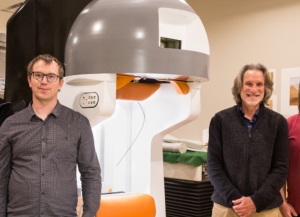by
John R. Fischer, Senior Reporter | June 06, 2023

Researchers in Minnesota and New Zealand have designed a portable, compact MR system for use in areas that have limited access to imaging. (Photo courtesy of University of Minnesota)
The University of Minnesota and Te Herenga Waka—Victoria University of Wellington, in New Zealand, are investing $12 million from two grants supplied by the National Institutes of Health into the development of a 0.7T portable MR for head scans, which they hope will improve access to imaging in remote and resource-limited areas.
Designed with a ~500 kg 0.7T magnet, the solution is relatively small and lightweight, enabling it to be transported and used almost anywhere to image brain function and structure. According to study principal investigator Dr. Michael Garwood, a professor in the U of M Medical School, the system's electrical power needs could, in principle, be met using a gas powered generator.
Unlike standard MR magnets, it does not require liquid helium. Instead, it uses a cryo-cooler to keep the magnet superconductive, and frequency-modulated RF pulses, the key ingredient in this technology, make MR scanning possible when the magnet has large-field nonuniformity. Garwood says that the field strength, (which is about ten times greater than that of Hyperfine's 0.064T Swoop system, for comparison) can be increased in the future for higher quality images.



Ad Statistics
Times Displayed: 174494
Times Visited: 3183 For those who need to move fast and expand clinical capabilities -- and would love new equipment -- the uCT 550 Advance offers a new fully configured 80-slice CT in up to 2 weeks with routine maintenance and parts and Software Upgrades for Life™ included.
"The magnetic field produced by any small, compact magnet is unavoidably less uniform than a large magnet like that used in conventional MRI systems," Garwood told HCB News. "As a result, when using a compact magnet, the resonance frequency varies to a greater extent across the object to be imaged. With compact magnets, the challenge is to excite all these different resonance frequencies with the conventional (constant-frequency) pulses that are most often used in MR. With frequency-modulated pulses, any frequency can be excited by varying (modulating) the frequency of the pulse during its transmission. This requires developing new pulse sequences based on FM pulses, which we have done."
The research team at the U of M’s Center for Magnetic Resonance Research plans to use the machine to create different types of images for various research purposes, and then launch a pilot study to evaluate its use in communities where access has been historically limited, such as Native American tribal areas.
"We expect to compete well with standard state-of-the-art 0.7 to 1.5 T clinical MRs, and do all the same types of applications (e.g., diagnose brain tumors, stroke, microvascular disease, white matter lesions)," said Garwood. "We're not there yet, but with more funding and continued work in our lab in the coming few years, we expect to have the necessary pulse sequences implemented to generate all the different contrasts needed clinically."
Patients insert their head into the MR bore, which has a window for them to look out, helping to reduce anxiety during the exam.
Garwood says the fact that it requires less space and infrastructure should make it attractive to providers and incentivize resource-limited communities to address health inequities, perform research to improve their understanding of brain development and degeneration in diverse populations, and improve access to quality clinical care. The technology may also be applied to make other small MR scanners for other body parts.
The scanner has been under development for the past eight years. Funding from the first grant was for planning and investigating the feasibility of the MR system, while the second is currently in a no-cost extension and providing the funds to build it. The team has expressed interest in commercializing the system in the future.
Other institutions involved include Universidade de São Paulo, Harvard University, Yale University, and Columbia University.

